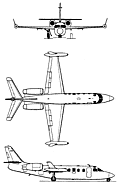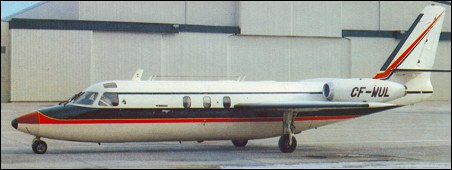|
| Israel Aircraft Industries' Westwind business jet may be traced back to the American Aero Commander Model 1121 Jet Commander which was designed by Ted Smith and first flew in January 1963. When Aero Commander merged with North American Rockwell they were obliged to sell off the Jet Commander to avoid conflict with US antitrust laws (the parent company was already marketing the Sabreliner business jet).
Israel Aircraft Industries bought the entire Jet Commander programme and all production tooling and sales rights, and after refining the design returned it to the market as the 1123 Commodore Jet, later renamed the 1123 Westwind. The West-wind had a lengthened fuselage, more powerful engines and tip tanks. The longer fuselage could accommodate up to ten passengers. The first Israel-built Westwind 1123 flew on September 28, 1970 and 36 had been delivered when production ceased in mid 1976 in favour of the Model 1124 which was re-engined with fuel-efficient Garrett-AiResearch TFE731 turbofans in place of the pure turbojets used in all previous models.
The first Model 1124 Westwind flew on July 21, 1975 since when production of the aircraft, known as Westwind I, has been running at three to four per month to meet heavy demand from United States business operators. The pressurized cabin can accommodate up to ten passengers with a flight crew of two. The interior arrangement can be altered to suit customer requirements. The cabin is heated, ventilated and air-conditioned. More than 90 have been delivered.
Three Model 1123 Westwinds were modified for maritime surveillance roles for the Israeli navy in 1977 and a maritime aircraft called the Westwind Sea Scan is today based on the 1124 airframe. It incorporates Litton LASR-2 search radar in a bulbous nose radome, Global Navigation's NS-500A VLF navigation system, forward-looking infrared scanner systems, low-light-level television cameras and monitors, magnetometers and sonobuoys, depth chargers or emergency-rescue equipment.
A further civil version called Westwind II is currently under development in Israel featuring drag-reducing Whitcomb winglets mounted atop the aircraft's tiptanks, which are expected to improve cruise performance by some 70km/h and range by 560km.
 | A three-view drawing (1176 x 1824) |
| MODEL | Westwind I |
| CREW | 2 |
| PASSENGERS | 10 |
| ENGINE | 2 x 1680kg Garrett-AiResearch TFE731-3-1G turbofans |
| WEIGHTS |
| Take-off weight | 10659 kg | 23499 lb |
| Empty weight | 5578 kg | 12297 lb |
| DIMENSIONS |
| Wingspan | 13.65 m | 45 ft 9 in |
| Length | 15.93 m | 52 ft 3 in |
| Height | 4.81 m | 16 ft 9 in |
| Wing area | 28.64 m2 | 308.28 sq ft |
| PERFORMANCE |
| Max. speed | 872 km/h | 542 mph |
| Range | 4619 km | 2870 miles |
| lxbfYeaa, e-mail, 14.03.2024 01:50 20 reply | | lxbfYeaa, e-mail, 14.03.2024 01:44 20 reply | | lxbfYeaa, e-mail, 14.03.2024 01:43 20 reply | | lxbfYeaa, e-mail, 14.03.2024 01:33 20 reply | |
| | lxbfYeaa, e-mail, 14.03.2024 01:30 20 reply | | lxbfYeaa, e-mail, 14.03.2024 01:29 20 reply | | 0, e-mail, 14.03.2024 01:23 20 reply | | -1 OR 3+459-459-1=0+0+0+1, e-mail, 14.03.2024 01:22 20 reply | | lxbfYeaa, e-mail, 14.03.2024 01:21 20 reply | | lxbfYeaa, e-mail, 14.03.2024 00:20 20 reply | | Pat Donaghy, e-mail, 31.03.2017 18:37 I flew both the 1123 & 1124 for several thousand hours. GREAT airplanes but the 24 much better with the new engines. Fuel consumption first hour was 1,000 lbs less than the GE engine. One unusual feature on the 24 that I grew to love on short or snow covered runways was the ability to deploy the reversers while still in flight. Pop them out on the flare and smooth short landing roll. reply | | Donald-duck, 15.05.2012 10:58 if you reduce the tire air pressure a bit you can make less bouncy landings. reply | | Brent van de Stadt, e-mail, 12.08.2011 08:10 Would like some advice on this jet, we are looking at starting up a air freight company from Australia to Hong Kong /South Korea, any body got some advice on this type of jet as the freight carrier only , any advice would be appreciated, or if you have recommendations would be appreciated as well. Thanks. reply | | laozhu, 18.06.2011 11:30 The real downfall of this airplane was the relatively small cabin for the range it had and the aggressive marketing of the larger cabin (and less capable) Hawker of the same class. reply | |
| | Scott Boyd, e-mail, 11.06.2011 07:23 I got to knell in the cockpit for a 40 mile, very,low altitude trip to get jet fuel, the airport I worked at didn't have it yet. Down and back, about as much taxi time as flught time. reply | | Robert Ragozzino, e-mail, 10.06.2011 20:37 I have hundreds of hours in Westwind 1 and IIs. They are great airplanes, fly like great business jets, and not trucks. I can generally make very nice landings. Average pilots drive them on hard. They are the best jet in their class for the money and the numbers prove that case. They also have the largest cabin in the small class, have big baggage areas, work on the hour schedule and not calendar as far a s maintenance, great range, fast enough, and very reliable. These are facts, not opinion. reply | | Lance Fishman, e-mail, 18.12.2010 00:53 Good article but the link needs correcting.
The company on the link is shown as Ayres not IAI. Ayres is a United States manufacturer of crop dusting aircraft. reply | | Bill Evans, e-mail, 17.03.2009 18:20 I flew 1200 hrs on the Jet Commander 1121 and 500 hours as a sales pilot on the 1123. I cannot agree with David Hoover.In the early seventies few if any medium sized corporate jets had power assisted controls. The 1123 was a very easy airplane to fly in all weather conditions. The provision of an auxiliary power unit later withdrawn on the 1124 made start up proceedures and pre flight air conditioning a great improvement on the 1121.Three consecutive smooth landings tested a pilots expertise and luck. reply | | Davd, e-mail, 06.07.2008 01:11 About 800 hours in this airplane. Mostly the IAI 1124 Westwind I (the one without the winglets). The IAI 1124A Westwind II has a different wing (a little more fuel) and winglets and vortex generators. It is a M0.80 airplane with very good range and payload. Non-boosted controls made this airplane a real dump truck to fly, but it was a fantastic instrument platform. It was solid as a rock on an ILS and built like a tank. Very dependable. It was a very difficult airplane to make a good landing in. The large single main tires and lack of trailing link main gear caused it to bounce on touchdown on all but the luckiest of landings. The real downfall of this airplane was the relatively small cabin for the range it had and the aggressive marketing of the larger cabin (and less capable) Hawker of the same class. reply |
|
Do you have any comments?
|
| 
All the World's Rotorcraft |






